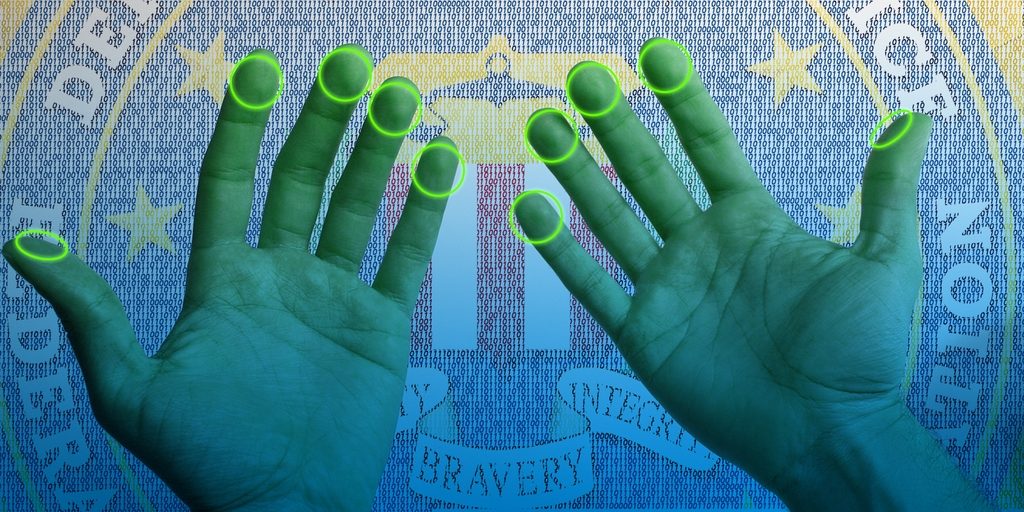Military and U.S. Law Enforcement Establishing Joint Communication Network for Biometric Databases
ANGLO AMERICA, 8 Oct 2018
Nicholas West | Activist Post – TRANSCEND Media Service
2 Oct 2018 – Does anyone remember that it used to be considered a conspiracy theory to warn people about biometric databases? Well, now that it is an accepted reality, we should be looking even farther down the slippery slope for new signposts indicating even greater plans to track, trace and database all human beings.
Apparently it is neither sufficient — nor efficient — to have the myriad databases currently at the disposal of agencies like the Department of Defense, FBI or Homeland Security. According to a release from Biometric Update, these agencies currently use different computer languages that have difficulty communicating with each other as seamlessly as the U.S. government desires.
The U.S. Defense Department, the FBI, and the Department of Homeland Security are planning to establish a new standard in 2019 to allow their biometric databases to communicate seamlessly, DoD officials told an audience at the AFCEA (Armed Forces Communications and Electronics Association) Federal Identity Forum in Tampa, Florida, SIGNAL reports.
The Electronic Biometric Transmission Specification (EBTS) version 4.1 will enable the DoD’s ABIS, DHS’s IDENT, and the FBI’s NGI (next generation identification) system to communicate natively, “in their own language,” according to DoD biometrics program chief engineer Will Graves. DHS is preparing to upgrade from its IDENT system to the new Homeland Advanced Recognition Technology (HART) in order to handle scale and capabilities far beyond those it was originally designed for.
“Hopefully we’ll be able to close the transactional and interoperability gap between DOD and DHS,” he says.
(Source)
Perhaps most notable is the apparent conflation of military systems and U.S. national justice systems into one overall sharing network. While the military is supposed to be restrained by Posse Comitatus from showing up on American soil to police the public, things appear to be more malleable where data collection systems are concerned.
The FBI is already mired in controversy for its role in attempting to suppress information about the domestic NGI database cited in the quote above. Activist Post reported about this massive database that contains fingerprints, palm prints, iris, voice, and face scans, as well as other biometric data of millions of non-criminal Americans.
In early May the U.S. Department of Justice released a proposal which would exempt the FBI’s biometric database from public disclosure. Specifically, the proposal would exempt the Next Generation Identification (NGI) System from provisions of the federal Privacy Act, which “requires federal agencies to share information about the records they collect with the individual subject of those records, allowing them to verify and correct them if needed.” The proposal is open for public comment until June 6, 2016.
Although the database does contain biometric data on convicted criminals, it also contains information on individuals who were only suspected or temporarily detained under the suspicion of a crime. The system also features data from people fingerprinted for jobs, licenses, military or volunteer service, background checks, security clearances, and other government processes.
Essentially the FBI is arguing that it will prevent individuals from knowing if their information is in the massive database if the release of information would “compromise” a law enforcement investigation.
[…]
Jeramie Scott, a national security counsel at the Electronic Privacy Information Center, told NextGov that the proposal “would set a worrying precedent in which law enforcement has significant leeway to decide what information to collect without informing the subject.”
One can only assume that the military’s Automated Biometrics Identification System (ABIS) is even more immune from transparency. Nevertheless, this fact, in addition to the usual privacy and security concerns raised daily about what happens to our data after collection, also appears not to be an impediment as, “Modernizing the DoD’s biometric system, which is at least five years old, may include moving the ABIS to the cloud.” My emphasis added.
As I noted with the latest news that India’s national biometric ID database was ruled constitutional by its highest court, are Americans right to assume that its own constitutional protections will not be violated even as the evidence continues to mount that a similar system is being designed?
Go to Original – activistpost.com
DISCLAIMER: The statements, views and opinions expressed in pieces republished here are solely those of the authors and do not necessarily represent those of TMS. In accordance with title 17 U.S.C. section 107, this material is distributed without profit to those who have expressed a prior interest in receiving the included information for research and educational purposes. TMS has no affiliation whatsoever with the originator of this article nor is TMS endorsed or sponsored by the originator. “GO TO ORIGINAL” links are provided as a convenience to our readers and allow for verification of authenticity. However, as originating pages are often updated by their originating host sites, the versions posted may not match the versions our readers view when clicking the “GO TO ORIGINAL” links. This site contains copyrighted material the use of which has not always been specifically authorized by the copyright owner. We are making such material available in our efforts to advance understanding of environmental, political, human rights, economic, democracy, scientific, and social justice issues, etc. We believe this constitutes a ‘fair use’ of any such copyrighted material as provided for in section 107 of the US Copyright Law. In accordance with Title 17 U.S.C. Section 107, the material on this site is distributed without profit to those who have expressed a prior interest in receiving the included information for research and educational purposes. For more information go to: http://www.law.cornell.edu/uscode/17/107.shtml. If you wish to use copyrighted material from this site for purposes of your own that go beyond ‘fair use’, you must obtain permission from the copyright owner.
